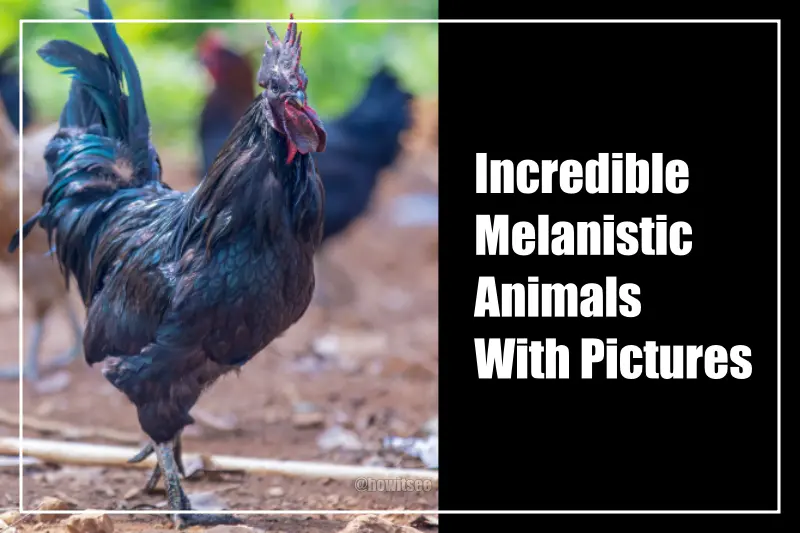We discussed a lot of colorful animals in previous blogs. But have you seen melanistic animals like black panthers and black guinea pigs? In this article, we will talk about these 20 incredible melanistic animals.
What is Melanism in animals?
Melanism is the condition in which organisms produce excess melanin, which results in a darker-colored body or dark patches over the body. It is the exact opposite of albinism. It is due to a lot of reasons, like genetic mutations, climate change, and human effects like industrial melanism.
Animals are adapted this way to better survive in nature. They get camouflaged due to their dark color, which helps them avoid predators and increases their chances of finding food.
How Rare is Melanism?
Melanism is not a fixed phenomenon; genetic mutations, natural selection, and the environment influence it. Melanism depends on species and the environment.
Its rarity varies from species to species. In some animals, like the black panther, the frequency is high, while in others, like the eastern grey squirrel, the frequency is low. It can also change over time due to natural selection, like in peppered moths.
20 Incredible Melanistic Animals
1. Black Panther
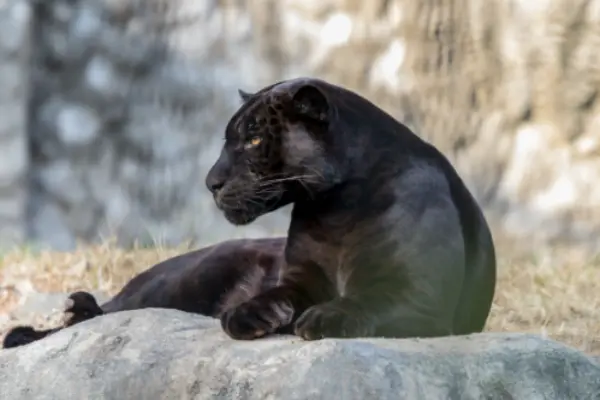
| Species | pardus, onca |
| Scientific Name | Panthera pardus, Panthera onca |
| Diet | Carnivore |
| Habitat | near water streams, rivers, and in flooded forests |
The Black Panther is not a distinct species. They are the melanistic forms of species in the Panthera genus. They are black due to the accumulation of excess melanin, which is caused by genetic mutations. Their body furs are so glossy black with green emerald eyes, which makes them so graceful.
They also have spots on their bodies, like jaguars and leopards, but they aren’t visible due to their dark hair color. This melanism gives an advantage to this nocturnal animal and helps it find prey.
2. Black Wolf
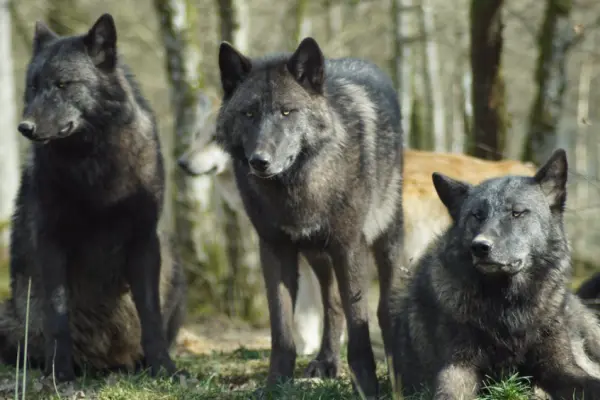
| Species | lupus |
| Scientific Name |
Canis lupus |
| Diet | Carnivore |
| Habitat | open forests and tundras |
The black wolf is the melanistic color variant of the gray wolf, Canis lupus. Mutations in the k locus gene are the reason for melanism in these animals. They mostly prefer open forests to tundras.
This melanism provides them with many advantages, like camouflage, thermoregulation, and resistance to pathogens. They are commonly found in West Asia and the Indian subcontinent. These color variations are rare in nature.
3. Silver fox
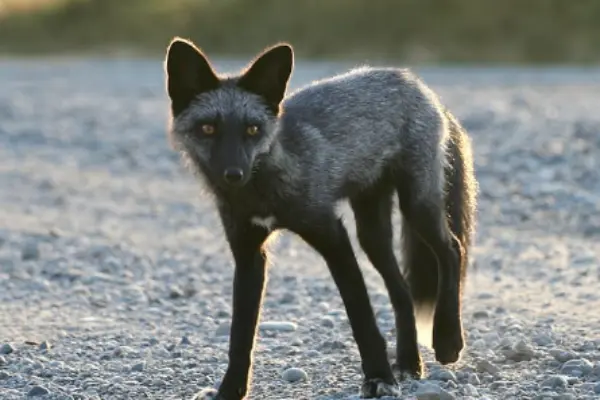
| Species | vulpus |
| Scientific Name | Vulpes vulpes |
| Diet | Carnivore |
| Habitat | forest zones and forest-tundra belts |
The silver fox is another example of a melanistic animal. They are the color variant of red foxes, Vulpes vulpes. They have a glossy black appearance with a white tail ending.
It is widely distributed in the northern hemisphere and Australia. The gene melanism is dominant in the case of silver foxes. These carnivorous animals are opportunistic feeders and are not very picky regarding food.
4. Melanistic eastern blue-tongued lizard
https://in.pinterest.com/pin/458311699574097729/
| Species | scincoides |
| Scientific Name | Tiliqua scincoides |
| Diet | Omnivorous |
| Habitat | dense vegetation, leaf litter, hollow logs, or piles of debris |
Melanistic eastern blue-tongued lizards are elegant, with a jet-black appearance and characteristic blue tongue and orange underside. These omnivorous animals generally use their blue tongues to warn their predators.
Due to their rare appearance, they are popular among animal lovers who keep them as pets. The Australian government has initiated many campaigns to save these rare lizards. These non-venomous lizards occur in urban and suburban areas of Australia.
5. Melanistic eastern gray squirrel
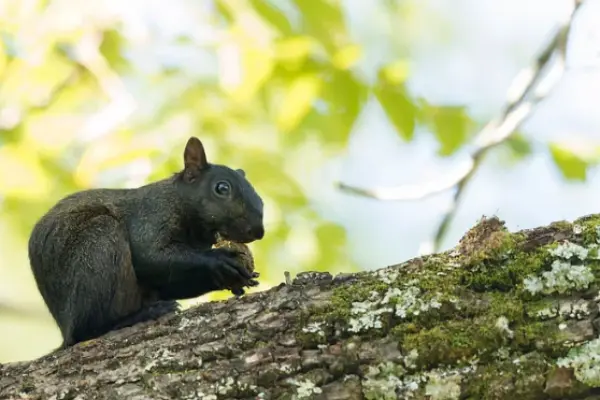
| Species | carolinensis |
| Scientific Name | Sciurus carolinensis |
| Diet | Herbivore |
| Habitat | temperate Terrestrial Biomes |
It helps them to warn the predators and for thermoregulation. These black morphs coexist with the non-melanistic ones in the same habitat and often interbreed. They primarily prefer temperate, terrestrial biomes in North America.
5. Melanistic European rabbit
| Species | cuniculus |
| Scientific Name | Oryctolagus cuniculus |
| Diet | herbivore |
| Habitat | temperate, tropical, and terrestrial |
The melanistic European rabbits are rabbits that have a black color due to excess melanin. These rabbits are native to the Iberian Peninsula, France, and the Atlas Mountains in North Africa, inhabiting grasslands, woodlands, etc.
Melanism provides advantages for rabbits, such as reducing heat stress and increasing camouflage. These animals are well-known for living in groups called Warrens.
7. Melanistic red-eared slider
| Species | scripta |
| Scientific Name | Trachemys scripta elegans |
| Diet | Omnivorous |
| Habitat | natural freshwater habitats |
Melanism in the melanistic red-eared slider is related to old age. Red-eared sliders have red patches on their necks, which make them different from other turtles.
Melanistic forms do not have these red patches on their backside; they are all black. One can find these turtles in North America. They are large, with an average carapace length of 12 inches.
8. Melanistic manta rays
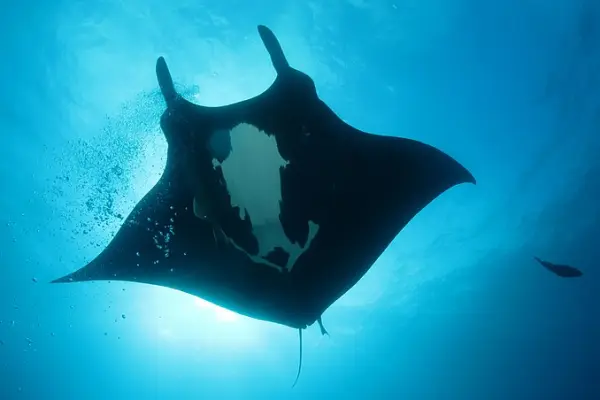
| Species | birostris |
| Scientific Name | Mobula birostris |
| Diet | Carnivorous |
| Habitat | in oceanic waters and in productive coastal areas |
Manta rays are quite a distinctively large animal, with a size of 30 feet. Melanism in marine animals is comparatively rarer than in land animals.
There is no reason to know why and how melanism occurs in manta rays. But according to the Marine Megafauna Foundation (MMF), it must be due to genetic drift.
There are no pros and cons to melanism in manta rays. It only advantages marine biologists to spot them easily for research work. They are commonly found in Indo-Pacific regions such as Indonesia and Australia.
9. Ayam Cemani Chicken
| Species | gallus |
| Scientific Name | Gallus gallus domesticus |
| Diet | Carnivorous |
| Habitat | agricultural areas, natural forests, planted forests, grasslands, scrub, and urban areas |
This Ayami cemani chicken is very rare in the Java Islands, Indonesia. They are known for their striking black appearance.
This coloration results from the genetic condition fibromelanosis, which leads to the accumulation of melanin in the body, which causes hyperpigmentation.
They have their own spiritual and economic values. These small chickens are used in many rituals and in cockfighting in Indonesia. They are not good breeders, but they can survive in harsh conditions.
10. Melanistic Forest Cobra
| Species | melanoleuca |
| Scientific Name | Naja melanoleuca |
| Diet | Carnivorous |
| Habitat | Savannas and lowland forests |
Melanism is observed in a variety of snakes. One example of these melanistic snakes is the Forest Cobra, Naja melanoleuca. These snakes coexist with normal individuals in the same habitat in West Africa.
These black morphs are very venomous and aggressive and they can grow up to 10 feet. These black morphs have some advantages over forest cobras in thermoregulation, camouflage, and protection from radiation.
11. Black king penguin
| Species | patagonicus |
| Scientific Name | Aptenodytes patagonicus |
| Diet | Carnivorous |
| Habitat | shores and valleys that are free of snow and ice |
Melanism is very common in the animal kingdom but is rare in penguins. The melanistic king penguins are rare and documented rarely in South Georgia. According to research, this trait is rare and occurs in one in every 25000 penguins.
Partial melanism is also seen in some species of penguins. There is not much information available about the advantages they get from melanism.
12. Black serval cat
| Species | serval |
| Scientific Name | Leptailurus serval |
| Diet | Carnivorous |
| Habitat | savanna |
Another member of the Serval cat family These medium-sized cats are commonly found in sub-Saharan Africa. Melanistic serval cats are rare and are not separate species; they are just color variants of Leptailurus serval.
The reason for melanism is still unknown in servals. According to the thermal melanism hypothesis, animals that live at high altitudes are more likely to get melanistic. Melanistic serval cats are glossy black with beautiful golden eyes.
13. Melanistic greater flamingo
| Species | roseus |
| Scientific Name | Phoenicopterus roseus |
| Diet | Carnivore, Molluscivore |
| Habitat | Saline lagoons, salt pans, large alkaline or saline lakes, and estuaries |
This phenomenon of melanism is very, very rare in greater flamingos. Researchers have only observed one melanistic greater flamingo on the Mediterranean island of Cyprus.
You can easily distinguish them from the flocks of greater flamingos by their black plumage and beak.
14. Melanistic barn owls
| Species | alba |
| Scientific Name | Tyto alba |
| Diet | Carnivorous |
| Habitat | open areas, forest edges, and clearings |
Barn owls are the most widely distributed species in the world. But melanistic barn owls are so uncommon that they occur only once in a lakh.
This animal’s unique coloration causes them to be rejected by their parents, targeted by predators, and only able to exist in captivity, making them extremely rare.
15. Melanistic guinea pigs
| Species | porcellus |
| Scientific Name | Cavia porcellus |
| Diet | Herbivorous |
| Habitat | moist savannas to forests and deserts |
Animal lovers highly admire black guinea pigs for their beauty and elegance. These rare melanistic forms have remarkable jet-black coloration due to excess melanin. Their unique coloration and cute features make them very popular as pets.
Breeders tried to produce them in captivity to meet the demand, as they are rare in the wild. In South America, people use them in rituals and believe that they are a sign of superpowers.
16. Melanistic Caiman
| Species | niger |
| Scientific Name | Melanosuchus niger |
| Diet | fish, reptiles, birds, and mammals, such as capybaras, deer, tapirs, and even jaguars |
| Habitat | Slow-moving rivers, streams, lakes, flooded savannahs and wetlands |
The next melanistic animal we have on our list is the black caiman. As the name itself indicates, these animals are dark greenish-black in color due to the high concentration of melanin in their skin.
They are regarded as the biggest living member of the alligator family, measuring between 5 and 6 cm.
This keystone species usually feeds on fish, reptiles, birds, and mammals, such as capybaras, deer, tapirs, and even jaguars.
Probably, their dark color aids in protection during their nocturnal hunts.
17. Peppered moth
| Species | betularia |
| Scientific Name | Biston betularia |
| Diet | Flower nectars, fruit pulps, leaves, and sometimes plant seeds |
| Habitat | Shrublands, parklands, deciduous and mixed-wood forests |
You must have heard about peppered moths. Peppered moths are a classic example of natural selection.
Usually they have speckled black-and-white wings, but due to certain genetic mutations, overproduction of melanin occurs, which leads to melanism in these moths.
They had an advantage over regular moths because they blended very well with their environment, as the natural selection hypothesis says.
18. Black salamander
| Species | atra |
| Scientific Name | Salamandra atra |
| Diet | worms, insects, spiders, slugs, frogs, lizards, and mice |
| Habitat | in mountainous region |
These alpine salamanders are found across Europe, including the French Alps. hey are almost black or have a hint of yellow, which makes their predators stay away from them.
But the question arises: What’s the reason behind their black color? According to their evolutionary history, these animals’ excess melanin in their skin, which aids in thermoregulation and concealment, is the reason they are black in color.
Scent marking techniques for marking their territories are seen in these salamanders.
19. Black bobcats
| Species | rufus |
| Scientific Name | Lynx rufus |
| Diet | Rabbits, hares, mice, and ground birds |
| Habitat | wooded areas, semidesert, urban edge, forest edge, and swampland environments |
You must have seen bobcats, as they are very common in North America. But have you ever come across a black bobcat? Yes, you heard it right, black bobcats.
This variant of bobcat is very rare in nature. There are, if we count them, fewer than twenty in the globe, primarily in Florida.
They are adaptive in nature and inhabit various habitats like wooded areas, semidesert, urban edge, forest edge, and swampland environments.
With the exception of mating season, they prefer to live alone.
20. Melanistic coyotes
| Species | latrans |
| Scientific Name | Canis latrans |
| Diet | rabbits, snakes, frogs (not toads), deer and other ungulates, turkeys and other large birds |
| Habitat | temperate forests |
Typically, coyotes are gray, brown or yellow in color, but melanistic coyotes are black in color.
They are commonly found in the southeastern United States. Their coloration helps them to conceal well in areas with dense canopy and wetlands.
Melanism in coyotes is the result of hybridization between coyotes, dogs and wolves.
Their dissimilar hues make it challenging for them to locate a partner.
Conclusion
Melanism is a common trait found in animals across the world, from cats to penguins. They have both advantages and disadvantages for animals. These rare and captivating melanistic forms reveal the many unique secrets that remain to be uncovered in this diverse animal kingdom.
Also Read:

Being a zoology student I’m always been fascinated toward animals especially insects. I love to do research and learn about different animals. As a writer I want to share my thoughts about nature through my articles. Apart from this you can find me exploring the new places and voice notes.
